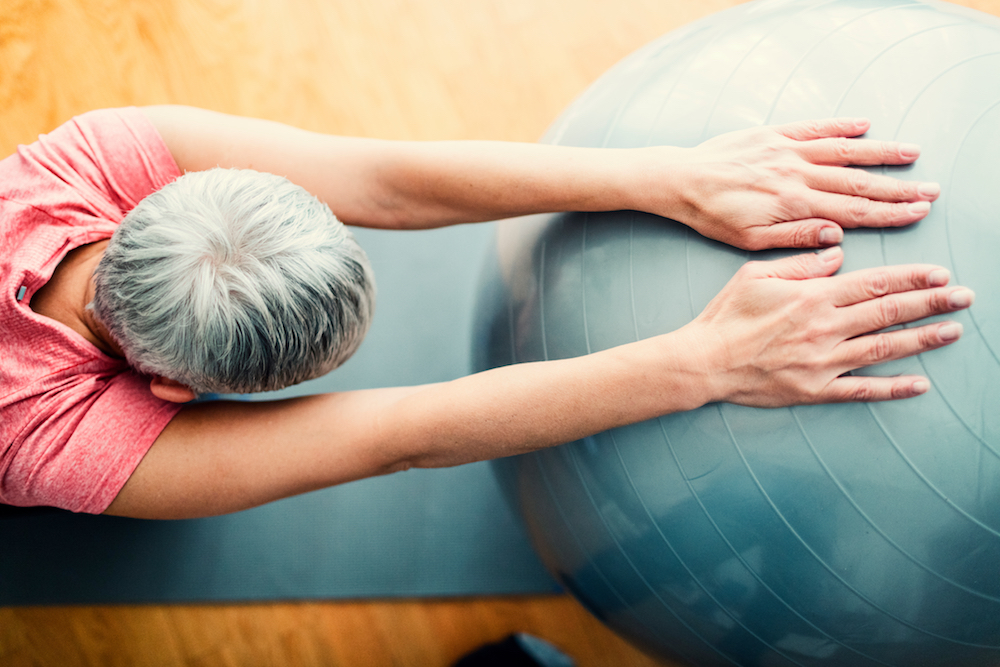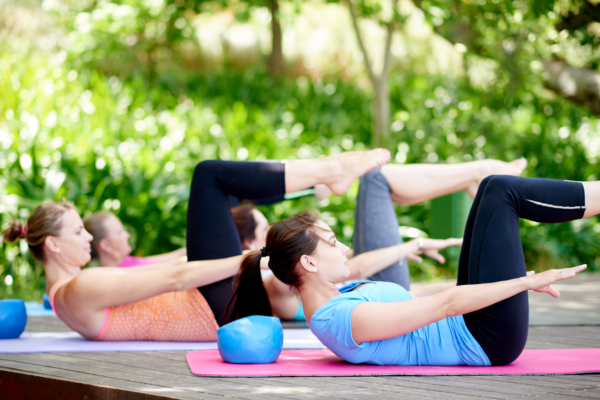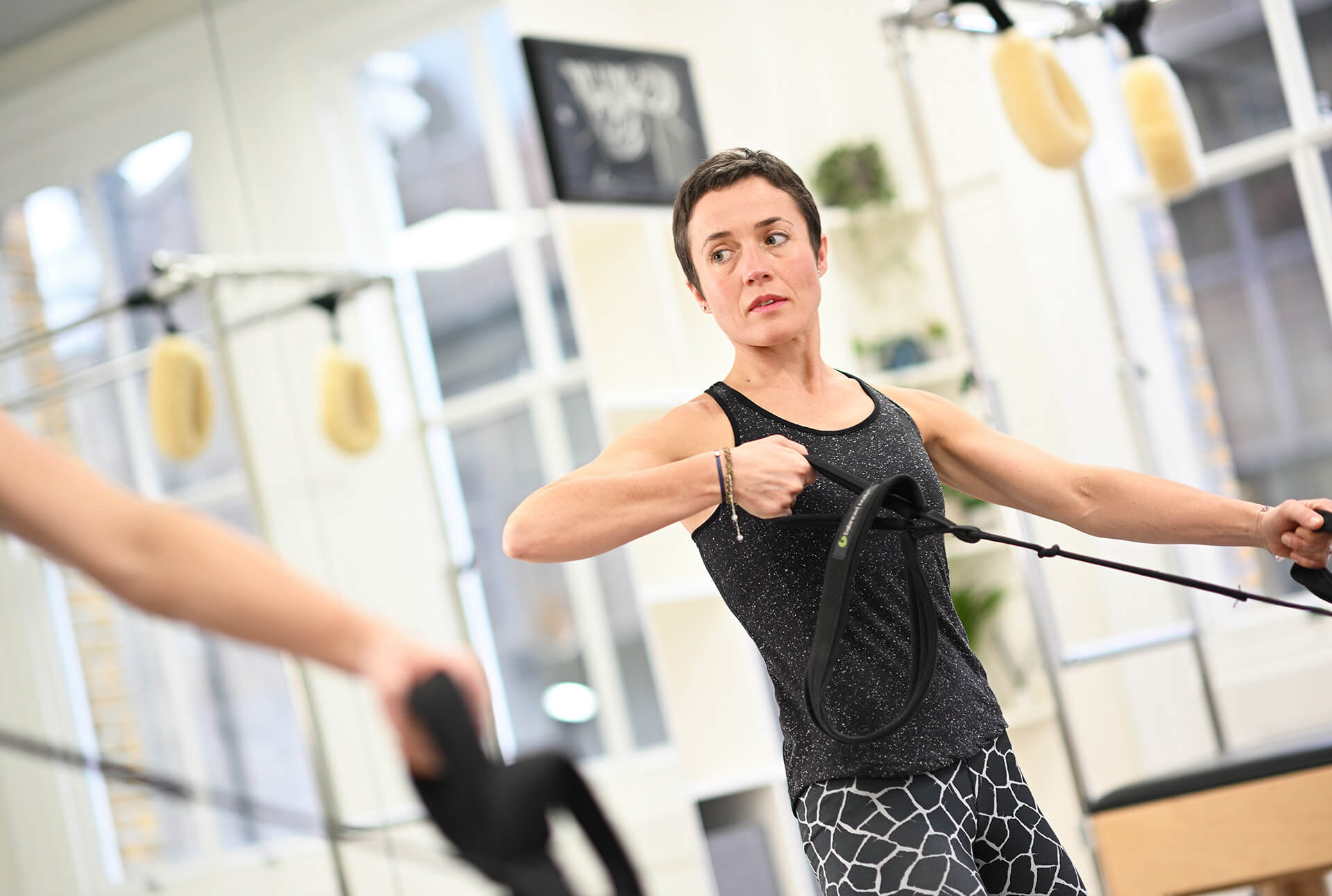Out of all the small props, balls like the Stability and Over ball (also called a Pilates Ball) arguably the most versatile and effective devices when it comes to enhancing a Pilates practice. These props can add challenge to just about any exercise and target muscles in a way the other props can’t.
Another plus: most of the Pilates exercise balls are also cheap and easy to get your hands on. You’ll even find some of them in your local gym. In fact, regular gym goers will likely already be familiar with (and know the advantages of using) one prop: the Stability ball.
Unless you’re a Pilates aficionado, however, you won’t have come across the other Pilates balls. And this means you won’t be incorporating them into your fitness routine. If this is the case then you’ll be missing out on the physical benefits that result from regular use.
This is why Complete Pilates are here: to show you what a Pilates exercise ball is and how easy and beneficial it is to use a Pilates ball.
Stability ball
What is it?
The stability ball – otherwise known as a fitness, gym or Swiss ball – is made from soft elastic and filled with air.
Stability balls come in a range of sizes (ranging from 45cms – 85cms in diameter) to suit people of different heights and to work for different exercises.
Despite the variety of sizes, these are still the largest of all the “small” props, and because of this are usually used for big, full-body exercises.
Uses
The stability ball is a versatile piece of kit that can be used in a wide variety of ways.
In gym circles, the ball is often used as a replacement for a weights bench. In Pilates, however, the stability ball is more often used for equipment-style movements that incorporate the whole body.
An example of one of these is the reverse abs exercise.
As the name suggests, this exercise targets the abdominals. Thanks to the addition of the stability ball, however, the upper body, including the arms and shoulders, also get a workout during this exercise.
The stability ball is also effective when used for strengthening the hamstrings and glutes. Common exercises on this ball include hamstring curls and hip thrusts. We also like to use this prop to add challenge to the basic Pilates bridge.
When used in the right way, the ball’s curved surface can also make a good alternative to the ladder barrel for those people who want to practise equipment-type Pilates outside of the studio setting.
Benefits
Like a reformer on a light spring, the unstable surface of the ball automatically creates more muscle activation in the body when exercises are performed on it. Because of this, the ball requires more balance and coordination than if you were performing, say, a basic bridge on a fixed platform. Generally, this means that Pilates exercises using a stability ball are more difficult than those executed just on the mat.
As well as adding challenges, the ball can also provide support during exercises. For example, the curved surface is great for acting like the ladder barrel and supporting the spine into extension (e.g. a backbends) outside of the studio environment.
Why does this matter? Well, when done properly, extension exercises increase mobility of the upper spine, an area which is often stiff. Creating movement in the mid-back improves posture and can reduce things like neck and shoulder pain.
Over ball
What is it?
The Over ball is a soft, air-filled ball about the size of a netball. It can be used partially or fully inflated, depending on its intended use.
Uses
The Over ball is a useful addition to both equipment and mat exercises. In contrast to the stability ball, the Over ball is particularly suited to targeted activation and strengthening work.
For instance, partially inflated, this ball can be placed behind the sacrum on the reformer or on the mat or either support or challenge the lumbar and lower abdominal region.
In the same state, this ball can be used to increase the challenge in exercises like mat or reformer footwork, or the supine spring series on the trapeze table.
Placed between the shoulder blades, a fully inflated Over ball can also be used for extension movements.
Benefits
The Over ball can be used squeezed between knees in footwork on the reformed to strengthen the inner thighs – and, as a result, the pelvic floor. Without the squeeze, this ball can also be used merely as a guide to keeps good alignment in legs and prevent knees and feet rolling inwards.
When used behind the sacrum, an Over ball can also add an element of instability during exercises like footwork on the reformer and deadbugs/femur arcs on the mat to increase activation of the lower abdominals.
Placing a partially deflated Over ball behind the head can help to relax the neck and ease tension in that area.
Massage balls
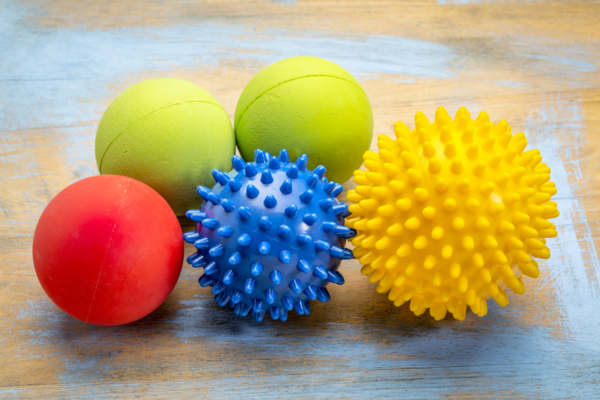
Self massage and reflexology therapy balls
Franklin balls, spiky balls, Pinky balls – these are some of the smallest props we use in our Pilates studio.
Most of these are tennis ball size and are, except for the Franklin ball, solid, hard plastic.
CP know the benefit of these purpose-designed props – we use them daily with our clients. Having said that, a simple tennis ball can be a cheap and often equally effective alternative to these specialist props.
Uses
Generally, these balls are used for massage and release work.
They prove particularly effective when used to release tension in areas like the shoulders, the feet and glutes. In fact, we often advise our clients to spend time working on these areas using these props after a hard workout or a long day at the office.
Benefits
As opposed to the foam roller, which is an effective way of massaging large areas of the body, a spiky or Pinky ball is an effective way of targeting and releasing really specific areas of tight, knotted muscle.
CP say:
Use them together and the results are even better. In combination, the massage ball and foam roller are an effective method of self-massage. Regularly using these props in this way can remove movement restrictions and help you avoid injury.
When used on the feet, these massage balls are also a great way of working out tension in the feet, as well as waking up the nerve receptors there. CP find this a great way to start a Pilates session. We also suggest trying this at the end of a long day wearing restrictive shoes – but do it from a seated position to avoid any bruising.
5 Pilates Ball Exercises to try
1. Pilates Ball Thoracic Extension Mobility
This exercise is perfect for those who experience stiffness in the upper back, especially if you’re sat at a desk all day. It encourages extension of the thoracic spine and allows you to stretch the muscles of the chest and help encourage deep breathing.
The exercise:
- Lie on your back on a mat, with your knees bent, with a half deflated ball under the centre of your spine, around the bra-line area.
- If you experience neck pain or your neck is uncomfortable in this position, place a pillow or folded towel under your head.
- If you feel the stretch is too strong, deflate the ball. Alternatively, if you feel you’d enjoy a greater stretch, you can inflate the ball a little more.
- In this position, relax your shoulders, back and hips and take deep breaths into the abdomen, and out through the nose.
- If you would like to open your chest further, you might enjoy relaxing your arms out to the side or even above your head. Alternatively, you can move your arms in and out and these positions dynamically.
- To begin with, only spend 1-2 minutes in this position and slowly increase the time each time you practise.
- Before getting up from the floor, it’s a good idea to lie on your back without the ball for a minute or two.

2. Pilates Ball Y-W Scapula Strength Exercise
This scapula and upper back strengthening exercise is great if you want to improve your posture and counteract all that time spent on the computer!
The exercise:
- Lying on your stomach, place a 75% inflated ball under the centre of your sternum.
- Keep your chest and head off the floor, with your eyes gazing straight down, and gently draw your belly button in towards your spine.
- Start with your arms in a ‘W’ position (arms lifted off floor, elbows bent, with hands in line with your ears) and shoulder blades gently drawn together.

- Reach your arms forward into a ‘Y’ position (arms above head at about 45 degrees) without letting your hands drop any closer to the floor.

- Return your arms to the W position.
- Try 8-10 repetitions and build up to 3 sets.
3. Pilates Ball Chest Lift
Mastered the Pilates chest lift already? Why not try this popular Pilates exercise with a pilates ball for an extra core burn.
The exercise:
- Start by lying on your back with the pilates ball half inflated and in the centre of your spine around bra-line level. Have your knees bent and feet flat on the floor. Interlace your fingers behind your head and keep your elbows wide but within your peripheral vision.
- Breathe in, on your exhale, slide your ribs towards your pubic bone and come into a small sit up, with your gaze just above your knees.
- Slowly lower back down over the pilates ball.
- Aim for 6-8 repetitions and try to build to 3 sets.
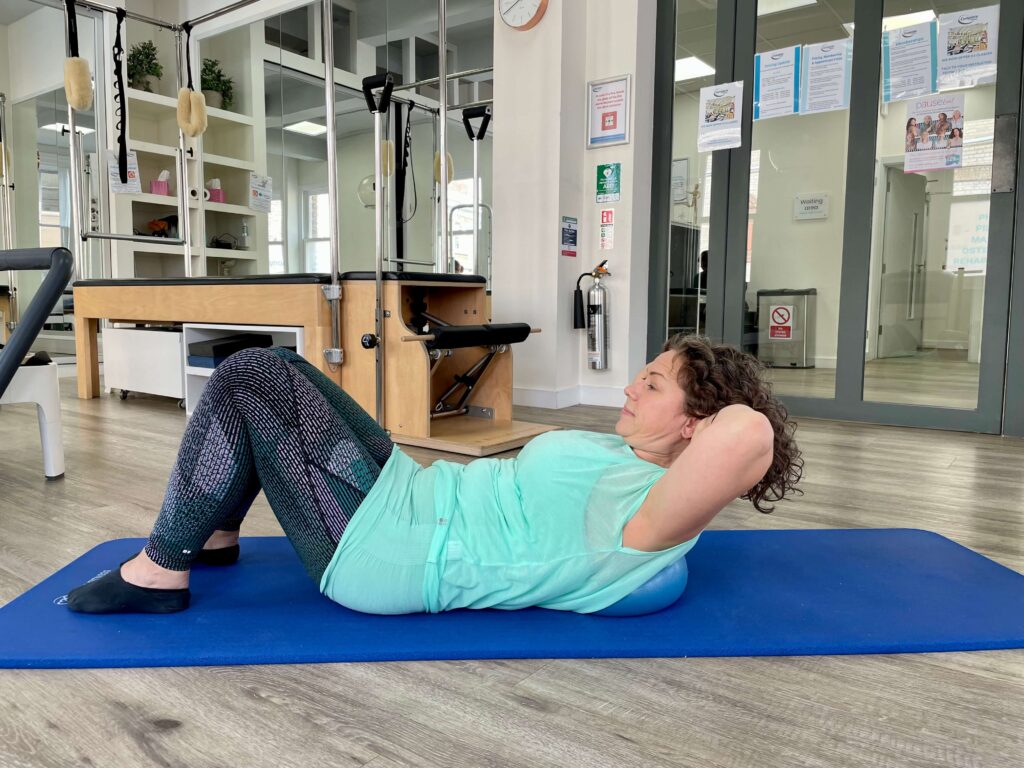
4. Pilates Ball Femur Arc
The femur arc is a classic Pilates exercise. Using the pilates ball under the sacrum can help reduce pressure on the lower spine and also make the movement more challenging by testing the stability of your pelvis and core.
The exercise:
- Lying on your back, with a half inflated pilates ball under the centre of your sacrum. Place your arms by your side.
- Slowly bring your legs up to table top position one at a time.
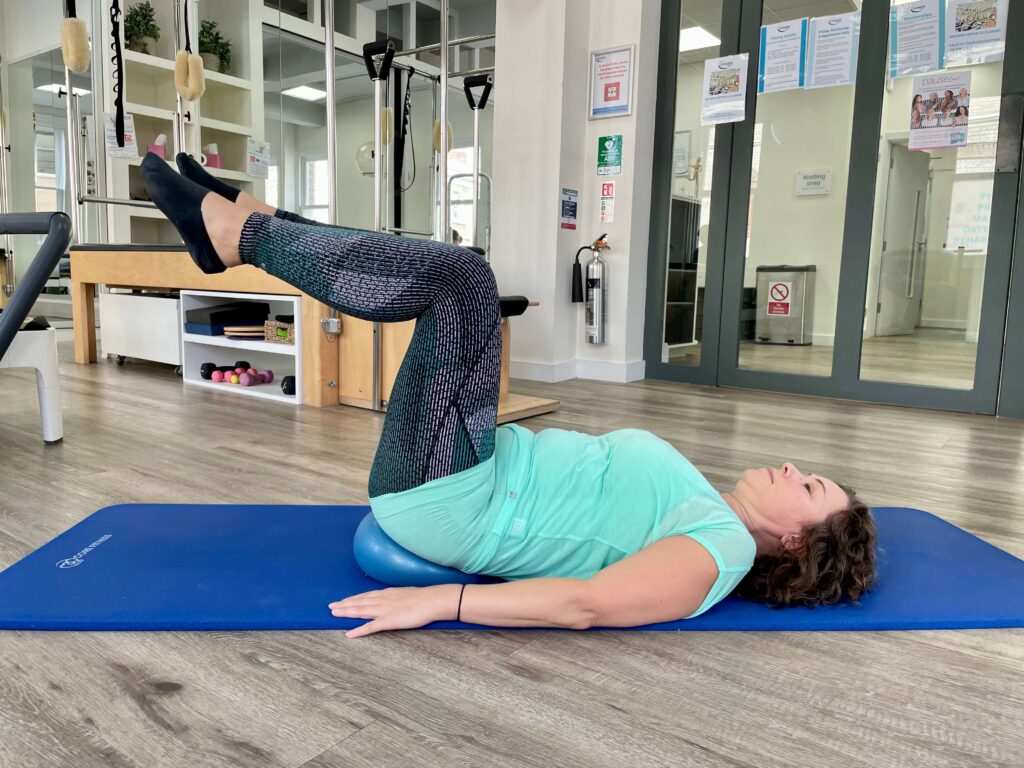
- Allow one bent leg to arc away from you, only as far as the toe gently taps the floor. Bring it back to the starting position.
- Keep your lower abdominals engaged and check that your lower back isn’t arching as you lower your back. If it is, try taking the leg only halfway to the floor to start and then slowly progress your range.
- Alternate sides. Aim for 2-3 sets of 8 repetitions.

5. Pilates Ball Hamstring Leg Lift
This is a great exercise to strengthen your hip extensors – your hamstrings and glutes!
The exercise:
- Start on all fours with the Pilates ball wedged into the back of your knee crease. Ensure your knees are stacked under your hips and your hands under your shoulders. Press your hands into the floor to keep your chest lifted between your shoulder blades. Keep your eye gaze straight down to the floor.
- Keeping your body from swaying side to side, squeeze the ball between the back of your lower and upper leg behind your knee, and slowly lift the back of your leg up to the sky. Only raise so far as your back doesn’t arch.
- Slowly lower the knee back to the ground.
- Repeat 6-8 times per leg and build up to 2-3 sets per side.

What size Pilates Ball do I need?
If you’re wanting to get some of these props for home, you might be wondering which one to choose. You’ll find all of these props come in many shapes, sizes and colours!
The stability ball tends to come in 3 main sizes; 55cm, 65cm or 75cm. The sizes differ to accommodate differences in height of the user. Typically, when you purchase a stability ball, information regarding the ideal corresponding height-to-ball size will be displayed, so you can choose the right one for you.
The Pilates ball/over ball also comes in multiple sizes, however we recommend the 7 inch ball for most people.
Massage balls typically come in pretty standard sizes however there can be differences in shape, how soft they are, whether they have spikes/grooves and also in their size. When choosing the right one for you, it depends on what you’re using it for and what your personal preference is. If you’re unsure we recommend giving them a try in your Pilates class first or asking your instructor for a recommendation.
The take away
We’ve mentioned quite a few different variations of the Pilates ball here, all of them with unique uses and benefits.
But while we know there are huge advantages of incorporating each one into your exercise routine, we understand that you might not want to go out and buy a whole load of specialist Pilates props.
Our solution? We suggest trying what is around you first and seeing what a difference it makes before you invest in these devices. Use a tennis ball for some massage work and the stability ball for bridging and ab work at the gym, for example.
Or, even better, why not book into a Pilates mat or reformer class or a 1:1 session and use them under expert guidance to get the most from these brilliant props.
Looking for Pilates in London? Our Pilates studios in Kensington, our Islington Pilates studio and our Pilates studio near Shoreditch, offer a highly tailored approach to your Pilates training, whether your goal is to manage a health condition, rehabilitate from an injury or to improve your strength and fitness.
Education is key:
These blogs are designed to give information to everyone, however, it is important to remember that everyone is different! If you have not seen one of our therapists and have any questions about injuries, what you have read or whether this may be useful to you, please just ask. We are more than happy to help anyone and point you in the right direction. Our biggest belief is that education is key. The more you understand about your injury, illness and movement, the more you are likely to improve.


